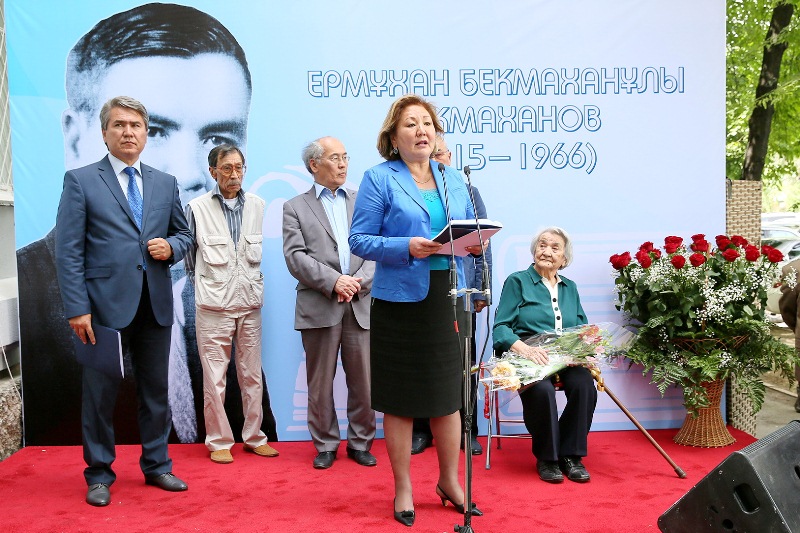On May 15 in Almaty, a memorial plaque was dedicated to prominent Kazakh historian Ermukhan Bekmakhanov, who would have turned 100 this year. Bekmakhanov was repressed under Stalin, standing accused of “bourgeois nationalism” for his research on the last Kazakh Khan, Kenessary Kassymov, leader of the anti-imperialist uprising of 1837-1847. The memorial was installed on the façade of the house where the well-known scholar worked and lived.
“He had a short but very meaningful life of only 50 years. I am still amazed by how in such a short period of time, he became a double Ph.D. in different fields. The dedication of this plaque shows that our country remembers and honours its heroes of all sorts. Today, we are truly celebrating,” the scientist’s son Sermukhan Bekmakhanov said.
Deputy Akim (Mayor) of Almaty Zauresh Amanzholova noted that the plaque’s dedication is taking place during the 550th anniversary of the formation of the Kazakh Khanate and Bekmakhanov turning 100.
“In December 1952, he was sentenced to 25 years in a labour camp for “anti-Soviet activities”. In February 1954, with help from [prominent Russian specialist on Kazakh history] Academician Anna Pankratova, Bekmak hanov was released. Despite his difficult life, he reached great heights in the professional world. In order to commemorate this national figure and honour his memory, we are opening a memorial plaque in his name,” Amanzholova said.
The event was attended by scientists, public figures, followers and friends of the historian.
Bekmakhanov was born in 1915 in Bayanaul, which is located in the Pavlodar region. One of his major researches was a book titled “Kazakhstan in the 1820s-1840s.” It was commended by prominent Kazakh and Russian scholars after its publication in Moscow in 1948 but in December 1950 became a subject of harsh criticism in the article “Marxist-Leninist study of Kazakhstan history issues is needed” published in the Soviet Communist Party’s official newspaper Pravda. Following that, a campaign was organised against Bekmakhanov, with him being stripped of his scientific titles and honours, fired from office, and finally sentenced to 25 years of exile in Siberia starting in December 1952. Stalin’s death in March 1953 was followed by a political “thaw” that allowed release of many of those unjustly persecuted, and thanks to this Bekmakhanov regained his freedom in February 1954. The efforts of his friends and admirers both in Almaty and Moscow allowed him to return to an active academic life.
Bekmakhanov’s other notable works include “Kazakhstan’s Integration into Russia,” “Essays on the History of Kazakhstan in the 19th Century,” as well as textbooks for secondary schools. Bekmakhanov, the founder of the Chair of History of Kazakhstan in the Kazakh National University named after Al-Farabi died in 1966 in Almaty.
Next month, a movie about Bekmakhanov called “Amanat” by prominent Director Satybaldy Narymbetov produced by Kazakhfilm will be shown in cinemas across the country. The historical drama depicts the life of the repressed historian, who formed academic hypotheses about the largest anti-Tsarist Kazakh uprising of the 19th century led by Khan Kenessary.
The monument to Kenessary, which is a bronze horseman on a granite pedestal, is located on the banks of the Yessil River in Astana. Kenessary was the grandson of Abylai Khan and the last Kazakh Khan. He fought for the country’s independence and the freedom of the Kazakh people all his life. The creators of this monumental work of art are sculptor Nurlan Dalbai and architect Shota Valikhanov. The horseman’s height is seven metres and that of his pedestal is six metres, weighing a total of 10 tonnes. The monument was unveiled on May 10, 2001.
The monument’s symbolism also lies in a historical fact that in one of the notable successes of the insurgency, on 2 June 1838, Kenessary’s forces captured the fortress of Akmolinsk, which was founded by the Tsar’s army eight years prior to the event and which gave the foundation for the town of Akmolinsk that is today’s Astana.
In 2013, the mass grave of Khan Kenessary’s guards was discovered in the centre of Astana. According to experts, this is a unique discovery of significant importance for the history of Kazakhstan.
According to Director of the Institute of Contemporary Studies at the Gumilev Eurasian National University, Mukhit-Ardager Sydyknazarov, a group of researchers who were searching for the remains of Kenessary Khan’s soldiers near an old cemetery near the Molodezhny micro district, found a tombstone with an Arabic inscription.
According to a rough translation made by Sydyknazarov, the tombstone was laid in 1838, in the month of Radjab, during the holy days of abstinence. He reported that there are about 250 warriors resting in the grave, most of them died rather young.


